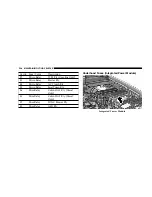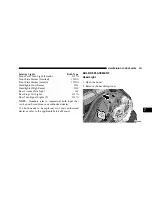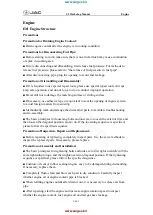
5. Remove the dipstick, wipe it clean and reinsert it until
seated.
6. Remove the dipstick again and note the fluid level on
both sides. The fluid level should be between the “HOT”
(upper) reference holes on the dipstick at normal operat-
ing temperature. The fluid level is only valid if there is a
solid coating of oil is seen on both sides of the dipstick. If
the fluid is low, add as required into the dipstick tube.
Do
not overfill.
After adding any quantity of oil through the
oil fill tube, wait a minimum of two (2) minutes for the oil
to fully drain into the transmission before rechecking the
fluid level.
NOTE:
If it is necessary to check the transmission
below
the operating temperature, the fluid level should be
between the two “COLD” (lower) holes on the dipstick
with the fluid at approximately 70°F (21°C) (room tem-
perature). If the fluid level is correctly established at
room temperature, it should be between the “HOT”
(upper) reference holes when the transmission reaches
180°F (82°C). Remember it is best to check the level at the
normal operating temperature.
CAUTION!
Be aware that if the fluid temperature is below 50°F
(10°C) it may not register on the dipstick. Do not add
fluid until the temperature is elevated enough to
produce an accurate reading.
7. Check for leaks. Release parking brake.
To prevent dirt and water from entering the transmission
after checking or replenishing fluid, make certain that the
dipstick cap is properly reseated. It is normal for the
dipstick cap to spring back slightly from its fully seated
position, as long as its seal remains engaged in the
dipstick tube.
338
MAINTAINING YOUR VEHICLE
Summary of Contents for 2005 Grand Cherokee
Page 2: ......
Page 96: ...96 UNDERSTANDING THE FEATURES OF YOUR VEHICLE ...
Page 97: ...UNDERSTANDING THE FEATURES OF YOUR VEHICLE 97 3 ...
Page 98: ...98 UNDERSTANDING THE FEATURES OF YOUR VEHICLE ...
Page 162: ...INSTRUMENT PANEL AND INTERIOR CONTROLS 162 UNDERSTANDING YOUR INSTRUMENT PANEL ...
Page 163: ...INSTRUMENT CLUSTER UNDERSTANDING YOUR INSTRUMENT PANEL 163 4 ...
Page 217: ...Operating Tips UNDERSTANDING YOUR INSTRUMENT PANEL 217 4 ...
Page 221: ...UNDERSTANDING YOUR INSTRUMENT PANEL 221 4 ...
Page 226: ......
Page 262: ...262 STARTING AND OPERATING ...
Page 294: ......
Page 310: ...3 7L ENGINE 310 MAINTAINING YOUR VEHICLE ...
Page 311: ...4 7L ENGINE MAINTAINING YOUR VEHICLE 311 7 ...
Page 312: ...5 7L ENGINE 312 MAINTAINING YOUR VEHICLE ...
Page 360: ......
Page 382: ......
Page 387: ...U S ONLY IF YOU NEED CONSUMER ASSISTANCE 387 9 ...
Page 391: ...INDEX 10 ...
















































